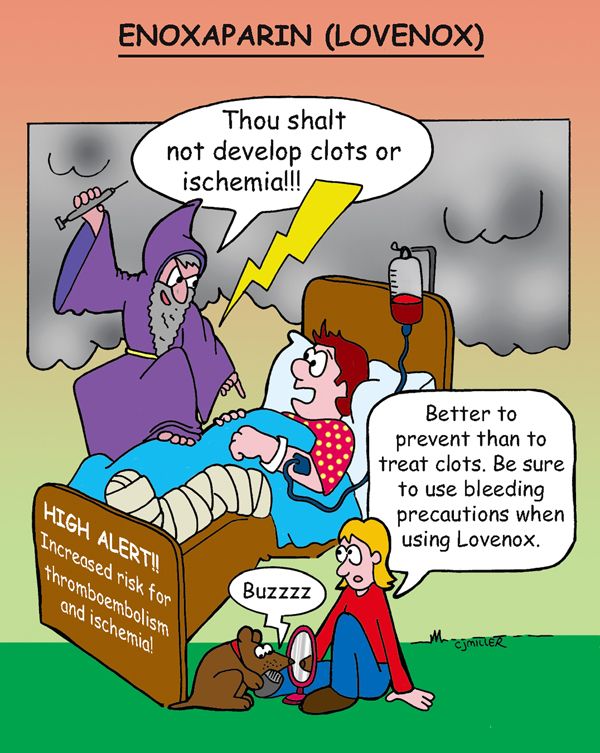Heparin

ACTION
Anticoagulant exerts direct effect on blood coagulation by enhancing the inhibitory actions of antithrombin on several factors essential to normal blood clotting, thereby blocking the conversion of prothrombin to thrombin and fibrinogen to fibrin.
USES
• Prevents and treats deep-vein thrombosis (DVT), pulmonary embolism, and emboli in atrial fibrillation.
• Treats disseminated intravascular coagulation.
• Is preferred anticoagulant during pregnancy.
• Prevents coagulation in heart-lung machines and dialyzers in patients after open-heart surgery and dialysis.
PRECAUTIONS AND CONTRAINDICATIONS
• Bleeding tendencies—hemophilia, dissecting aneurysm, peptic ulcer
• Thrombocytopenia, uncontrollable bleeding, threatened abortion
• Postoperative patients—especially eye, brain, and spinal cord surgeries; lumbar puncture; and regional anesthesia
SIDE EFFECTS
• Injection site reactions and †heparin-induced thrombocytopenia† may develop.
• Large doses may suppress renal function.
• May result in †spontaneous bleeding.†
NURSING IMPLICATIONS
1. *Monitor partial thromboplastin time (PTT) and activated PTT (aPTT)—should be 1½ to 2 times the normal range.* †Watch for bleeding.†
2. *Protamine sulfate is the antidote.*
3. Low–molecular-weight heparins (e.g., enoxaparin [Lovenox]) do not require PTT or aPTT monitoring; are used most often for preventing and treating DVT.
4. Administered either intravenously (IV) or †subcutaneously; apply firm pressure for 1 to 2 minutes; do not massage site after injection.†
Enoxaparin (Lovenox)

ACTIONS
Low–molecular-weight heparin (LMWH) with a great affinity for factor Xa in providing anticoagulation action; provides a predictable anticoagulant response.
USES
Treats and prevents postoperative deep-vein thrombosis, pulmonary embolism, unstable angina, or non–Q-wave myocardial infarction (MI).
CONTRAINDICATIONS
• Presence of any active bleeding
• Increased risk of hematoma in patients with spinal or epidural anesthesia
• Not to be used concurrently with other anticoagulants or aspirin
• †Not to be used in presence of thrombocytopenia†
SIDE EFFECTS
• Immune-mediated thrombocytopenia
• **Bleeding episodes**
NURSING IMPLICATIONS
1. Medication is only administered subcutaneously.
2. *Protamine sulfate is antidote.*
3. *Always double check—cannot be given to a patient receiving heparin.*
4. *Injections in abdomen should be 2 inches from umbilicus or any incisional area.*
5. ‡Advise patient not to take any over-the-counter (OTC) medications, especially aspirin.‡
6. Check complete blood count (CBC), especially platelet count.
7. *Monitor for bleeding:*
• *Guaiac stools for occult blood*
• *Hematuria*
• *Bleeding gums*
• *Excessive bruising*
Warfarin Sodium (Coumadin)

ACTIONS
Anticoagulant that antagonizes vitamin K, which is necessary for the synthesis of clotting factors VII, IX, X, and prothrombin. As a result, it disrupts the coagulation cascade.
USES
• Long-term prophylaxis of thrombosis; is not useful in emergency because of delayed onset of action.
• Prevents venous thrombosis and thromboembolism associated with atrial fibrillation and prosthetic heart valves.
• Decreases risk of recurrent transient ischemic attacks (TIAs), cerebrovascular accident (stroke), and myocardial infarction.
CONTRAINDICATIONS
• Bleeding disorders (hemophilia, thrombocytopenia)
• Vitamin K deficiency; severe hypertension
• Pregnancy—category X; breast-feeding (crosses into breast milk)
• Renal or liver disease, alcoholism
SIDE EFFECTS
• †Spontaneous bleeding†
• Hypersensitivity reactions (e.g., dermatitis, fever, pruritus, urticaria)
• Red-orange discoloration of urine (not to be confused with hematuria); weakening of bones with long-term use leading to risk of fractures
NURSING IMPLICATIONS
1. *Monitor prothrombin time (PT) and international normalized ratio (INR) as ordered (2 to 3 is usually an acceptable INR for anticoagulation).*
2. *Interacts with a large number of medications; consequently, monitor for drug interactions before initiating therapy.*
3. *Monitor for bleeding tendencies.*
4. *Vitamin K is an antidote.*
5. ‡Teach patient to decrease intake of green, leafy vegetables.‡
Stay updated, free articles. Join our Telegram channel

Full access? Get Clinical Tree




